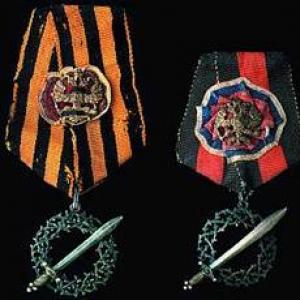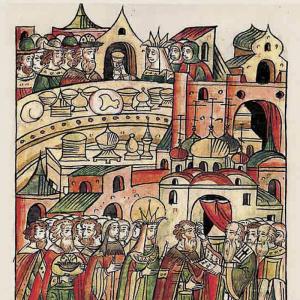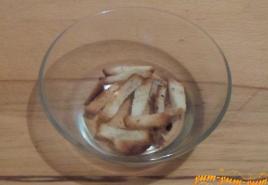Design of electric lighting in a production area. Design of lighting for industrial enterprises. Calculation of power loads
A project is an image of a future device or structure (system), presented in drawings, diagrams, tables, descriptions created on the basis of calculations and comparison of options.
For large and complex industrial complexes, buildings and structures, the lighting installation project is developed in two stages: technical design and working drawings.
Technical design of electric lighting for industrial premises
In the technical project, issues of the lighting and electrical parts of the lighting installation are resolved, assignments are issued for the design of power supply and basic construction solutions.
Working drawings of electric lighting of industrial premises
Working drawings are developed on the basis of the approved technical design.
The development of a technical working draft or working drawings should be carried out in accordance with the environmental conditions in the premises, in full compliance with the groups and categories of the environment, data on the power sources of the lighting installation must be established. When designing, it is recommended to study in detail the technological process of the illuminated enterprise and know the nature of the visual work performed in the premises.
The plans of the power supply network show the construction part of buildings in a simplified manner, display panels that indicate the number and installed power, and draw network lines indicating the brands and cross-sections of cables and wires. On the plans of the main premises, the installation locations of lamps and panels are fragmentarily outlined. Lamps, panels and various equipment are calculated according to plans and a table of indicators.
 Drawings of plans and sections contain basic information about lighting solutions and the electrical part of lighting installations.
Drawings of plans and sections contain basic information about lighting solutions and the electrical part of lighting installations.
When developing plans, it is necessary to use a set of symbols and requirements for the implementation of inscriptions and numbers specified in GOST 21-614-88.
The plans include lamps, main points, group panels, step-down transformers, supply and group networks, switches, plug sockets; the names of the premises, the standardized illumination from general lighting, the class of fire and explosion hazardous premises, types, installation height of lamps and lamp power are indicated. , methods of wiring and cross-section of wires and cables of lighting networks. The reference dimensions of installation locations for lamps, panels, and marks for laying lighting networks are indicated in cases where precise fixation of these locations is necessary.
 When designing buildings, a number of rooms of which have the same lighting solutions: lamps, lighting network and other identical elements, it is recommended that all solutions be applied only for one room; for others, an appropriate reference is made to it. The general floor plan shows only the entrances to such premises. Drawings of floor plans of all premises are made on a scale of 1: 100 or 1: 200.
When designing buildings, a number of rooms of which have the same lighting solutions: lamps, lighting network and other identical elements, it is recommended that all solutions be applied only for one room; for others, an appropriate reference is made to it. The general floor plan shows only the entrances to such premises. Drawings of floor plans of all premises are made on a scale of 1: 100 or 1: 200.
In addition to drawings of plans and sections of illuminated premises with lighting diagrams printed on them, the design documentation includes: custom specifications for electrical equipment and materials; construction buildings; scheme remote control or other circuit diagrams, non-standard installation drawings.
Supply and group networks on floor plans are drawn with thicker lines than the building elements of the building and equipment; the number of wires in group lines is indicated by the number of notches drawn at an angle of 45° to the network line.

Indication of groups throughout is necessary to ensure uniform phase loading. On panels without factory numbering of groups, connection phases are indicated. The plans include summary data, network voltages, links to symbols, and grounding information.
Electric lighting is divided into working, emergency, evacuation (), and security. If necessary, some of the luminaires of one or another type of lighting can be used for emergency lighting (lighting during non-working hours). Artificial lighting is designed in two systems: general and combined, when local lighting (workplace lighting) is added to general lighting.
Working lighting should be installed in all areas of buildings, as well as in areas where work is being carried out and vehicles are moving.
The calculation of a lighting installation consists of two parts: lighting and electrical.
The lighting part contains: selection of light sources, standardized illumination, type and lighting system, type of lamps, safety factors and additional illumination; calculation of the placement of lamps (determining the height of the suspension, the distance from the walls and between lamps, the number of lamps), luminous flux and lamp power.
Purpose of lighting calculations
Lighting calculations allow you to do the following:
a) determine the number and unit power of light sources of the lighting installation that provides the required illumination in the room (on the working surface);
b) for an existing (designed) lighting installation, calculate the illumination at any point on the surface of the illuminated room;
c) determine the quality indicators of the lighting installation (pulsation coefficient, cylindrical illumination, glare and discomfort indicators).
The main lighting engineering calculation of lighting is to solve problems according to the above points a) and b). For this purpose, the following methods are used: the luminous flux utilization coefficient method and .

Classification of lighting engineering methods for calculating lighting
Luminous flux utilization factor method used to calculate the overall uniform illumination of horizontal surfaces, mainly to calculate the luminous flux of the light source(s). This method also allows you to calculate the average illumination of a horizontal surface, taking into account all the fluxes incident on it, both direct and reflected. It is not applicable for uneven placement of lamps or calculation of illumination at characteristic points of both non-horizontal and horizontal surfaces.
A simplified form of the luminous flux utilization factor method is power density method per unit of illuminated area. This method is used for approximate calculations of overall uniform illumination. The maximum calculation error using the power density method is ±20%.
 The point method for calculating lighting allows you to determine the illumination at any point on the surface of the illuminated room for any uniform or uneven placement of lamps. It is often used as a verification method for calculating illumination at characteristic points of a surface. Using the point method, you can analyze the distribution of illumination throughout the entire room, determine the minimum illumination not only on a horizontal, but also an inclined surface, and calculate emergency and local lighting.
The point method for calculating lighting allows you to determine the illumination at any point on the surface of the illuminated room for any uniform or uneven placement of lamps. It is often used as a verification method for calculating illumination at characteristic points of a surface. Using the point method, you can analyze the distribution of illumination throughout the entire room, determine the minimum illumination not only on a horizontal, but also an inclined surface, and calculate emergency and local lighting.
The main disadvantage of the point calculation method is that it does not take into account the reflected light flux from the walls, ceiling and working surface of the room.
In cases where none of the above methods can be applied, for example, when calculating uneven lighting of a room with significant reflective properties of walls, ceilings and working surfaces, then both methods are used, acting in a combined manner.
The electrical part of the project contains: selection of locations for main and group panels, network route and layout, type of wiring and method of laying it; calculation of the lighting network based on permissible voltage loss, followed by checking the cross-section for continuous current and mechanical strength, protection of the lighting network; recommendations for installing a lighting installation; measures to protect against electric shock.
A production workshop, a warehouse, a conveyor - none of these objects can operate without lighting, which in this context is usually called industrial. Lamps various types increase productivity, reduce staff fatigue and ensure safety of the work process. Accordingly, increased requirements for reliability and functionality are placed on the design of lighting for industrial buildings and indoor workplaces.
Having trouble choosing lamps?
We will prepare a full calculation of the cost, necessary equipment and 3D visualization for lighting your facility. It's FREE - even before purchasing and concluding a contract, you will be able to evaluate:
“How much will it cost?”, “What will it look like?”, “How long will the meter run?”.
Types of industrial lighting
In industrial production, such types of lighting as natural, artificial and emergency are used. Let's take a closer look at each of them.
Daylight
It means the sun, the rays of which fall directly or reflected onto the illuminated object. There are several types of natural lighting in a building: top, side and combined. In the first case, light enters the room through openings in the ceilings. When applied from the side, it penetrates inside through openings in the walls. Both options combine combined lighting.
Artificial lighting
The need for it in production arose due to the inconsistency of the natural source - the sun. Working and duty (the second is used during non-working hours) provides visibility at work sites. For this purpose, luminaires with fluorescent, high-pressure gas-discharge lamps or LED sources are installed in buildings.
Emergency lighting
It is used in emergency situations and is divided into two types: for evacuation and for safety. The first provides the proper conditions for the prompt evacuation of people from the building and is represented by devices with inscriptions and signs. They are installed at exits or fire safety equipment locations. Lighting of industrial premises for safety purposes is required when turning off the main source leads to a dangerous situation: fire, poisoning, disruption of the technological process.
One of the types of artificial work lighting is LED. Industrial LED lamps are economical and ergonomic. They can be used in conditions of high humidity, at high and low temperatures, in dusty buildings. This is achieved due to the special housing design, which minimizes external influences on them and eliminates overheating. The last problem is solved by using radiators to remove heat.
LED elements are used in manufacturing plants and large buildings. They are capable of reducing electricity costs by 4-7 times compared to fluorescent and traditional sources. LED lamps are durable and do not require special care or maintenance. They have a high margin of safety, since the flask is made of polymer material, and therefore are suitable for difficult operating conditions. Even when broken, they do not release toxic substances, as is the case with fluorescent ones, so they do not pose a health threat to people present in the room.
Dome lamps

These suspended devices are designed for large industrial facilities (workshops, warehouse complexes, hangars) and other buildings with ceilings higher than 4 m. In addition to the dome design, they are characterized by a convenient fastening with a reflector rotation function. The configuration of the dome determines at what scattering angle the rays will propagate. Dome models have a dust- and moisture-proof housing (IP57 and higher), operate in a temperature range from -40 to +50 ° C and operate on average about 75 thousand hours.

Floodlights are installed not indoors, but also outside. They create a stream of rays and shape its transmission at a certain angle, depending on the design features of the housing, installed lenses and reflectors. Optical solutions that produce a beam of light at an angle of 15, 30, 45, 60 or 90° are common.
Ceiling lamps

Ceiling lamps are attached directly to the ceiling and create diffused rather than directed light, evenly illuminating the entire workshop, warehouse or other building. They can be built-in or overhead. Ceiling lamps are easy to maintain, economical and are also used for emergency lighting.
Individual lighting

It is used to highlight the work area of employees as much as possible, focus attention on details, or ensure compliance with safety regulations. It makes sense to equip the operator’s position on a conveyor belt or behind a machine. LED spotlights with a bright directional beam falling on the workplace one or two or three workers.
Lighting of workshops and warehouses
To solve this problem, LED solutions are widely used. They have proven themselves in the industrial sector for a number of reasons.
- Demonstrate cost effectiveness. They are 4-7 times more economical than halogen and fluorescent analogues and do not require regular replacement of starters.
- They last at least 50,000 hours. In practice, this figure reaches 75,000 and even 100,000 hours, which corresponds to 4-8 years of continuous operation.
- They pay for themselves within 6-12 months. This takes into account their service life, energy efficiency and it is assumed that they will be on 24 hours a day.
- They produce a luminous flux with different characteristics. Depending on the needs of production, the optimal values of the spectrum, power, and directivity are selected.
- Practical and reliable. Not only the service life of LED elements plays a role, but also the strength of the structure. They are not fragile, are not afraid of vibration and weigh little. They are not afraid of frequent switching on and off, dusty and humid rooms.

If a workshop, warehouse or other building has elongated shape, it is reasonable to install linear ceiling fixtures in it. Dome solutions are suitable for organizing local light flux. If natural light enters the production room, the operation of the artificial source must adapt to it. This problem is solved by manually turning on and off lighting fixtures or using sensors and timers that operate automatically throughout the entire area or in individual sectors.
The influence of industrial lighting on human performance

Artificial light affects biological processes in the human body. It determines the visibility of objects in the workplace and affects the emotional state, endocrine and immune systems, metabolic rate and other vital functions. important processes. Natural light from the sun is a priority for the human body. In order for artificial analogues to replace it, the spectral compositions of the radiation must match. Otherwise, visual discomfort leads to the following consequences:
- Fatigue
- Decreased concentration
- The appearance of a headache
- Difficulty recognizing objects
Requirements and standards for lighting of industrial premises
Industrial structures are designed taking into account approved standards. Current standards make it possible to organize comfortable and safe workplaces. Requirements and standards are listed in the set of rules SP52.13330.2011 (formerly SNiP 23-05-95) “Natural and artificial lighting”. Engineers are also guided by SP 2.2.1.1312-03 “Hygienic requirements for the design of newly built and reconstructed industrial enterprises”, GOST 15597-82 “Lamps for industrial buildings. General technical conditions" and industry standards. Here is a brief statement of the basic design rules set out in these standards.
- The level of illumination in an industrial workshop or other structure corresponds to the type of work that is performed in it.
- The brightness is the same throughout the entire room. This is achieved by painting walls and ceilings in light shades.
- The lamps used have spectral characteristics that ensure correct color rendering.
- There are no objects with pronounced reflective surfaces in a person’s field of vision. This avoids direct and reflected glare and thus eliminates the possibility of glare.
- The room is evenly illuminated throughout work shifts.
- The possibility of sharp and dynamic shadows appearing in workplaces, which lead to an increase in injuries, is eliminated.
- Lamps, wires, switchboards, transformers are located in places that are safe for others.
Calculation of industrial premises lighting
Ergonomically correct lighting design creates comfortable and safe working conditions. When choosing lighting sources for a workshop, it is customary to rely on three evaluation criteria:
- The amount of luminous flux. Based on this parameter, the illumination required for a building or a separate sector is calculated and the number of sources to provide it is determined. This takes into account the type and purpose of the room, the area and height of the ceilings, and takes into account building rules and regulations, including industry ones.
- Colorful temperature. Determines the intensity of light radiation and its color - from warm yellow to cool white.
- Terms of Use. It is important to take into account the average temperature in production premises, level of humidity, dust, vibration and other factors.
According to standards, if workers do not perform visual tasks, the brightness is 150 lm per 1 m2. If average visual load is assumed, this figure increases to 500 lm per 1 m2. In those rooms where they work with parts with a diameter of up to 10 mm, the luminous flux level is at least 1,000 lm per 1 m2. To obtain a luminous flux of 400-450 lm, you will need a 40 W halogen lamp, an 8 W fluorescent lamp or a 4 W LED lamp.
In the workplace, the color temperature is brought closer to the parameters of natural light. This is from 4,000 to 4,5000 K. If regular reading of documentation is expected, the color temperature is increased towards cool white, but not more than 6,000 K.

The power of the luminous flux is influenced by the installation features of the device (the higher it is located, the fewer lumens it produces), the presence or absence of a diffuser, and the degree of transparency of the glass. When choosing a specific light source, it is also customary to focus on the stability of the luminous flux, the efficiency of the selected product, its electrical parameters and safety requirements.
conclusions
Management companies and business owners in Moscow and beyond are increasingly using LED solutions for production and other facilities. LED light sources have declared themselves to be economical, durable, easy to maintain, comfortable for vision and safe from the point of view of constant exposure to the human body.
DESIGN OF ELECTRICAL LIGHTING FOR PRODUCTION PREMISES
For large and complex industrial complexes, buildings and structures, the lighting installation project is developed in two stages: technical design and working drawings.
In the technical project, issues of the lighting and electrical parts of the lighting installation are resolved, assignments are issued for the design of power supply and basic construction solutions.
Working drawings are developed on the basis of the approved technical design.
The development of a technical working draft or working drawings should be carried out in accordance with the environmental conditions in the premises; groups and categories of the environment and data on the power sources of the lighting installation must be established in full accordance with the PUE. When designing, it is recommended to study in detail the technological process of the illuminated enterprise and know the nature of the visual work performed in the premises.
The plans of the power supply network show the construction part of buildings in a simplified manner, display panels that indicate the number and installed power, and draw network lines indicating the brands and cross-sections of cables and wires. On the plans of the main premises, the installation locations of lamps and panels are fragmentarily outlined. Lamps, panels and various equipment are calculated according to plans and a table of indicators.
Drawings of plans and sections contain basic information about lighting solutions and the electrical part of lighting installations.
When developing plans, it is necessary to use a set of symbols and requirements for the implementation of inscriptions and numbers specified in GOST 21-614-88.
The plans include lamps, main points, group panels, step-down transformers, supply and group networks, switches, plug sockets; the names of the premises, the standardized illumination from general lighting, the class of fire and explosion hazardous premises, types, installation height of lamps and lamp power are indicated. , methods of wiring and cross-section of wires and cables of lighting networks (Fig. 2 a, b, c). The reference dimensions of installation locations for lamps, panels, and marks for laying lighting networks are indicated in cases where precise fixation of these locations is necessary.
When designing buildings, a number of rooms of which have the same lighting solutions: lamps, lighting network and other identical elements, it is recommended that all solutions be applied only for one room; for others, an appropriate reference is made to it. The general floor plan shows only the entrances to such premises. Drawings of floor plans of all premises are made on a scale of 1: 100 or 1: 200.
In addition to drawings of plans and sections of illuminated premises with lighting diagrams printed on them, the design documentation includes: custom specifications for electrical equipment and materials; construction buildings; remote control diagrams or other circuit diagrams, non-standard installation drawings.
Supply and group networks on floor plans are drawn with thicker lines than the building elements of the building and equipment; the number of wires in group lines is indicated by the number of notches drawn at an angle of 45 to the network line (Fig. 2)
Indication of groups throughout is necessary to ensure uniform phase loading. On panels without factory numbering of groups, connection phases are indicated. The plans include summary data, network voltages, links to symbols, and grounding information.
Electric lighting is divided into working, emergency, evacuation (emergency lighting for evacuation), and security. If necessary, some of the luminaires of one or another type of lighting can be used for emergency lighting (lighting during non-working hours). Artificial lighting is designed in two systems: general and combined, when local lighting (workplace lighting) is added to general lighting.
Working lighting should be installed in all areas of buildings, as well as in areas where work is being carried out and vehicles are moving.
The calculation of a lighting installation consists of two parts: lighting and electrical.
The lighting part contains: selection of light sources, standardized illumination, type and lighting system, type of lamps, safety factors and additional illumination; calculation of the placement of lamps (determining the height of the suspension, the distance from the walls and between lamps, the number of lamps), luminous flux and lamp power.
The electrical part of the project contains: selection of locations for main and group panels, network route and drawing up a power supply and lighting control circuit, type of wiring and method of laying it; calculation of the lighting network based on permissible voltage loss, followed by checking the cross-section for continuous current and mechanical strength, protection of the lighting network; recommendations for installing a lighting installation; measures to protect against electric shock.
Calculation of power loads.
Calculation of power load of three-phase consumers
Table 1 – Initial data
| No. | Machine type | Power Pn, kW | Number of n, pcs. | K and | |
| Lathes | 0,2 | 0,65 | |||
| Planing machines | 0,2 | 0,65 | |||
| Slotting machines | 2,7 5,4 | 0,2 | 0,65 | ||
| Milling machines | 0,2 | 0,65 | |||
| Drilling machines | - | 0,2 | 0,65 | ||
| Carousel machines | 0,2 | 0,65 | |||
| Sharpening machines | 0,2 | 0,65 | |||
| Grinding machines | 0,2 | 0,65 | |||
| Fans | 0,7 | 0,8 | |||
| Crane beam: PV=40% | 0,1 | 0,5 |
Solution:
1 According to the formula P cm = and, i P n, i, we determine the average shift power for electric vehicles operating in the same mode and with the same k and.
Group 1 – turning, planing, slotting, milling, drilling, rotary, sharpening, grinding machines (k and =0.2; =0.65; =1.17);
Group 2 – fans (k and =0.7; cos =0.8; tg =0.75);
Group 3 – beam crane (k and =0.1; cos =0.5; tg𝜑=1.73).
1 gr. Р cm 1 = 0.2(12∙8+5∙4+5∙8+9∙8+2.7∙3+5.4∙2+6∙5+12∙8+5∙10+10∙ 6+30∙2+11∙2+15∙4+26∙3+31∙1)=146.78 kW.
2 gr. R cm 2 = 0.7(7∙2+10∙2)=23.8 kW.
3 gr. R cm 3 =0.1∙(10∙2+22∙4)=6.83 kW.
2 We determine the effective number of EPs by group depending on the ratio Р n, max / Р n, min.
1 gr. n ef = =47 pcs.
2 gr. because Р cm = Р р, then n eff is not determined.
3 gr. because R n, max /R n, min ≤3, then n eff =n=6 pcs.
3 we determine the calculated coefficient K p.
1 gr. n eff =47 pcs.; K p =1.0
3 gr. n ef = 6 pcs.; K p =2.64
4 according to the formula P r = K r cm determine the calculated active power
1 gr. Р р1 = 1.0∙146.78= 146.78 kW.
3 gr. R р2 = 6.83∙2.64=18.03 kW.
The active total load in the machine shop is:
R r∑mechanical shop =146.78+23.8+18.03=188.61 kW.
5 Determine the estimated reactive power Q p using the formula
At n eff ≤10 Qp=1.1∙P cm ∙tg𝜑 i
At n eff 10 Q p =P cm ∙tg𝜑 i
1 gr. Q p =146.78∙1.17=173.73 kvar.
2 gr. Q p =1.1∙23.8∙0.75=19.635 kvar.
3 gr. Q p =1.1∙6.83∙1.73=13 kvar.
The total reactive load in the machine shop is
Q p ∑mechanical shop =171.73+19.635+13=204.365 kvar.
6 We determine the total power using the formula S p =
S p ∑mechanical shop = = = = 278.1 kV∙A.
Calculation of lighting load
Determine the lighting load of the foundry
Given: S p =868 kV∙A.
R ud. =12.6 W/m2
The lighting is done with DRL lamps.
1 Determine the area of the room using the formula
F room = = =2712.5 m 2
2 Determine R mouth.
R mouth =12.6∙2712.5=34.18 kW.
3 Determine P r, osv. , Q r.osv.
R r.osv. =0.95∙1.1∙34.18=35.72 kW.
Q r.osv. =35.72∙1.33=47.51 quar.
S p .dev. = = = =59.44 kV∙A.
Industrial premises lighting design
Utilization factor method
Design lighting for a mechanical workshop with dimensions of 45×25×12 m, height of lamp suspension h c =1.2 m, height of working surface h p =0.8 m, which is made with DRL lamps in RSP 05/G03 lamps. Number of lamps – 45 pcs. Normalized illumination E n = 300 lux, safety factor Kzap - 1.5. The distance between the lamps in length is 5.85 m, in width – 5.5 m (the distance from the wall to the lamp in length is 2 m, in width – 1.5 m)
Solution:
1 Determine the reflection coefficients from the ceiling, walls and working surface using the table.
Table 2 - Surface reflectance coefficients.
p p =0.3; р с =0.3; р р =0.1
2 Determine the room index using the formula:
where F is the area of the room
h – design height
A, B – length and width of the room
h=H-h p -h c =12-0.8-1.2=10
3 According to the application for i=1.6 and coefficients p p =0.3; р с =0.3; р р =0.1 we determine the utilization factor η=0.65
4 Determine the luminous flux using the formula:
F r. = = = =19904 lm.
Where E n – normalized illumination
To zap – safety factor
Z – minimum illumination coefficient (Z=1.1 for LL, Z=1.5 for
LN and DRL).
N – number of lamps
Based on the value of F r, we select a DRL lamp with a power of 400 W. With luminous flux F nom. – 22000 lm. Since F r.<Ф ном. на 10,5%, согласно условиям задачи корректируем количество светильников до 40 шт.
F r. = = = =22392 lm.
Based on the value of F r, we select a DRL lamp with a power of 400 W. With luminous flux F nom. – 22000 lm.
F r >F nom. by 1.78%, which corresponds to the parameters.
For large and complex industrial complexes, buildings and structures, the lighting installation project is developed in two stages: technical design and working drawings.
In the technical project, issues of the lighting and electrical parts of the lighting installation are resolved, assignments are issued for the design of power supply and basic construction solutions.
Working drawings are developed on the basis of the approved technical design.
The development of a technical working draft or working drawings should be carried out in accordance with the environmental conditions in the premises; groups and categories of the environment and data on the power sources of the lighting installation must be established in full accordance with the PUE. When designing, it is recommended to study in detail the technological process of the illuminated enterprise and know the nature of the visual work performed in the premises.
The plans of the power supply network show the construction part of buildings in a simplified manner, display panels that indicate the number and installed power, and draw network lines indicating the brands and cross-sections of cables and wires. On the plans of the main premises, the installation locations of lamps and panels are fragmentarily outlined. Lamps, panels and various equipment are calculated according to plans and a table of indicators.
Drawings of plans and sections contain basic information about lighting solutions and the electrical part of lighting installations.
When developing plans, it is necessary to use a set of symbols and requirements for the implementation of inscriptions and numbers specified in GOST 21-614-88.
The plans include lamps, main points, group panels, step-down transformers, supply and group networks, switches, plug sockets; the names of the premises, the standardized illumination from general lighting, the class of fire and explosion hazardous premises, types, installation height of lamps and lamp power are indicated. , methods of wiring and cross-section of wires and cables of lighting networks. The reference dimensions of installation locations for lamps, panels, and marks for laying lighting networks are indicated in cases where precise fixation of these locations is necessary.
When designing buildings, a number of rooms of which have the same lighting solutions: lamps, lighting network and other identical elements, it is recommended that all solutions be applied only for one room; for others, an appropriate reference is made to it. The general floor plan shows only the entrances to such premises. Drawings of floor plans of all premises are made on a scale of 1: 100 or 1: 200.
In addition to drawings of plans and sections of illuminated premises with lighting diagrams printed on them, the design documentation includes: custom specifications for electrical equipment and materials; construction buildings; remote control diagrams or other circuit diagrams, non-standard installation drawings.
Supply and group networks on floor plans are drawn with thicker lines than the building elements of the building and equipment; the number of wires in group lines is indicated by the number of notches drawn at an angle of 45° to the network line.
Indication of groups throughout is necessary to ensure uniform phase loading. On panels without factory numbering of groups, connection phases are indicated. The plans include summary data, network voltages, links to symbols, and grounding information.
Electric lighting is divided into working, emergency, evacuation (emergency lighting for evacuation), and security. If necessary, some of the luminaires of one or another type of lighting can be used for emergency lighting (lighting during non-working hours). Artificial lighting is designed in two systems: general and combined, when local lighting (workplace lighting) is added to general lighting.
Working lighting should be installed in all areas of buildings, as well as in areas where work is being carried out and vehicles are moving.
The calculation of a lighting installation consists of two parts: lighting and electrical.
The lighting part contains: selection of light sources, standardized illumination, type and lighting system, type of lamps, safety factors and additional illumination; calculation of the placement of lamps (determining the height of the suspension, the distance from the walls and between lamps, the number of lamps), luminous flux and lamp power.
The electrical part of the project contains: selection of locations for main and group panels, network route and drawing up a power supply and lighting control circuit, type of wiring and method of laying it; calculation of the lighting network based on permissible voltage loss, followed by checking the cross-section for continuous current and mechanical strength, protection of the lighting network; recommendations for installing a lighting installation; measures to protect against electric shock.







